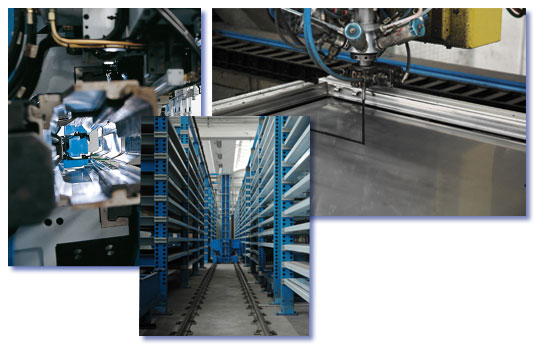
Our expertise
Stainless Steel is defined as a steel alloy which combines the mechanical qualities of regular steels with a specific anticorrosion quality exclusive in its kind. Stainless steel differs from carbon steel by the amount of chromium present: if exposed to air and moisture, steel rusts, creating an oxide film which is active and accelerates corrosion by forming more iron oxide.
Stainless steels contain sufficient chromium to form a passive film of chromium oxide, which prevents further surface corrosion and blocks corrosion from spreading into the metal's internal structure.
The chromium forms a passivation layer of chromium(III) oxide (Cr2O3) when exposed to oxygen. The layer is too thin to be visible, and the metal remains lustrous. The layer is impervious to water and air, protecting the metal beneath. Also, this layer quickly reforms when the surface is scratched. This phenomenon is called passivation and is seen in other metals, such as aluminium and titanium. Corrosion-resistance can be adversely affected if the component is used in a non-oxygenated environment, a typical example being underwater keel bolts buried in timber.
Stainless steels are also classified by their crystalline structure:
Martensitic stainless steels are not as corrosion-resistant as the other two classes but are extremely strong and tough, as well as highly machineable. Martensitic stainless steel contains hight percentage of chromium (12-14%) and it is commonly know by its American Standard: AISI 400.
Ferritic stainless steels have a lower chromium and nickel content.They generally have better engineering properties than austenitic grades, but have reduced corrosion resistance and cannot behardened by heat treatments. Most compositions include molybdenum; some, aluminium to increase resistance to heat, and sulfur to facilitate mechanical treatment.
Austenitic, or 300 series, stainless steels contain a maximum of 0.15% carbon, a minimum of 16% chromium and sufficient nickel and/or manganese to retain an austenitic structure at all temperatures.
The most common composition of 18% chromium and 8% nickel, is known as 18/10 stainless, 18/0 and 18/8 are also available. 18/8/30 stainless, with a 2-3% molybdenum content, offer even better resistance to corrosion.
Stainless steels contain sufficient chromium to form a passive film of chromium oxide, which prevents further surface corrosion and blocks corrosion from spreading into the metal's internal structure.
The chromium forms a passivation layer of chromium(III) oxide (Cr2O3) when exposed to oxygen. The layer is too thin to be visible, and the metal remains lustrous. The layer is impervious to water and air, protecting the metal beneath. Also, this layer quickly reforms when the surface is scratched. This phenomenon is called passivation and is seen in other metals, such as aluminium and titanium. Corrosion-resistance can be adversely affected if the component is used in a non-oxygenated environment, a typical example being underwater keel bolts buried in timber.
Stainless steels are also classified by their crystalline structure:
Martensitic stainless steels are not as corrosion-resistant as the other two classes but are extremely strong and tough, as well as highly machineable. Martensitic stainless steel contains hight percentage of chromium (12-14%) and it is commonly know by its American Standard: AISI 400.
Ferritic stainless steels have a lower chromium and nickel content.They generally have better engineering properties than austenitic grades, but have reduced corrosion resistance and cannot behardened by heat treatments. Most compositions include molybdenum; some, aluminium to increase resistance to heat, and sulfur to facilitate mechanical treatment.
Austenitic, or 300 series, stainless steels contain a maximum of 0.15% carbon, a minimum of 16% chromium and sufficient nickel and/or manganese to retain an austenitic structure at all temperatures.
The most common composition of 18% chromium and 8% nickel, is known as 18/10 stainless, 18/0 and 18/8 are also available. 18/8/30 stainless, with a 2-3% molybdenum content, offer even better resistance to corrosion.
SALES NETWORK | PRIVACY POLICY | GENERAL PURCHASE CONDITIONS | DOWNLOADS
Flextec srl - Via Villalta, 1 - 33082 Azzano Decimo (PN) - ITALY - Tel. +39 0434 420180 - Fax +39 0434 420110
